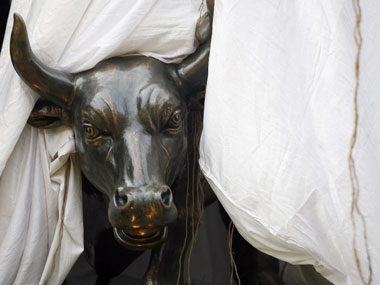The stock markets are poised at an interesting stage where they can go either way: the only determinant will be the direction of foreign investor inflows (FIIs). If more money gets in, the markets will stay afloat and rise. If not, they will stay listless and volatile.
Does the current market look inviting enough to the FIIs? Let’s look at the positives first.
The US and Europe are in deep trouble economically - while India is still looking like a fast-growing economy. Even after discounting the slowdown, we will still have 7.5-7.8 percent GDP growth this year.
A corollary: if the US and European slowdown forces the monetary authorities there to ease the money tap even more, India is sure to benefit more than proportionately from the inflows. This is what drove the markets in 2010.
Our share valuations are attractive. The Nifty price-earnings (P/E) ratio if around 18 times earnings - which is close to the average of the past 10-12 years. As recently as in November last year, the P/E was nearly 26. That’s a leeway of nearly 50 percent from current levels. Even better, at current market levels, the total market capitalisation is just 80 percent of gross domestic product (GDP). Three years ago it was at twice that level. That’s a 100 percent leeway for growth.
Interest rates are about to peak. The Reserve Bank may look at weakening growth to indicate a pause either this week or by the next policy review in October. Since interest rates and share prices are inversely related, that’s another cue for a positive market.
[caption id=“attachment_82091” align=“alignleft” width=“380” caption=“The Sensex will fall over the next month or two, but will start climbing after that once valuations become even more compelling.Reuters”]  [/caption]
Thanks to the rupee-dollar interest rate differential and the growth rate differential, it makes sense to invest in India. The rupee could thus strengthen from here. A rising rupee will amplify the portfolio values of FIIs that are already invested here. This could be a spur to further investment.
A weakening global growth climate is a positive for a country that imports more (especially oil) than it exports. A narrowing trade gap and/or current account deficit is another positive signal for inflows.
Thanks to a wrong forecast by the Indian Meteorological Department, we are going to have a good (normal) monsoon this year - with all the attendant benefits of lower food prices and rural demand. This means there could be a surprise kicker in the final growth figures for 2011-12.
With the UPA government in a beleaguered state, it needs to go for broke in terms of reforms to reverse the business sentiment. It has nothing to lose in terms of political capital by being bold on reforms. The chances it will take the plunge this year - when elections are still nearly years away.
As against this, there are only two big negatives for FII flows.
One is the rise in short-term global risk aversion which is driving investors to gold - and also the US dollar.
Secondly, the real worry for foreign investors is the narrow base of domestic investment. This is where the government needs to act: a market boom cannot stand on one leg - FII inflows alone. There has to be a strong domestic leg to balance this.
The world over, pension funds are the biggest investors in the markets. In India, pension funds barely invest in equity. A bolder approach to allowing pension and provident funds to invest in equity would provide exactly the kind of adrenaline the market requires to build its own steam.
That still leaves us with the question: will FIIs enter now or not, given the balance of positives in our favour?
One guess is that in the short-term the markets will fall because of risk-aversion in the US and elsewhere. US investors are already pulling the plug on European bonds and this is one reason for the strength of the dollar. The FIIs may continue to be iffy on India, too.
The numbers are showing this. Net FII investment in equity was an abysmal Rs 1,554 crore till the end of last week.
This is my prognosis: the Sensex will fall over the next month or two, but will start climbing after that once valuations become even more compelling.
But over the medium term, given our valuations, foreign investors have to bite the bullet and invest in emerging markets like India.
What goes down must come up.


)
)
)
)
)
)
)
)
)



